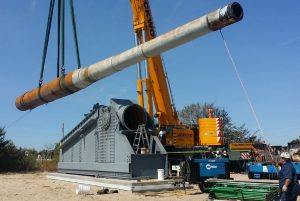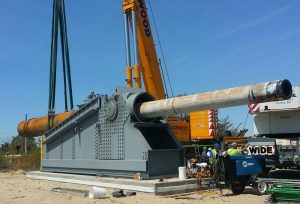16-inch gun which fired 2,700-pound shells was mounted on USS Missouri when Japan surrendered on Sept. 2, 1945 to end the Second World War
 LEWES – After wartime service in the Pacific aboard the storied “Mighty Mo” – the battleship USS Missouri – one of the ship’s nine original 16-inch guns that shook the enemy fleet with 2,700-pound shells was moved today to a permanent display within historic Fort Miles at Cape Henlopen State Park. Of yet another historic note, the big gun was mounted on the Missouri and overlooking her veranda deck when the Japanese surrender was accepted there Sept. 2, 1945, ending World War II.”Mighty Mo”‘s big gun moved to permanent resting place at Fort Miles in Cape Henlopen State Park
LEWES – After wartime service in the Pacific aboard the storied “Mighty Mo” – the battleship USS Missouri – one of the ship’s nine original 16-inch guns that shook the enemy fleet with 2,700-pound shells was moved today to a permanent display within historic Fort Miles at Cape Henlopen State Park. Of yet another historic note, the big gun was mounted on the Missouri and overlooking her veranda deck when the Japanese surrender was accepted there Sept. 2, 1945, ending World War II.”Mighty Mo”‘s big gun moved to permanent resting place at Fort Miles in Cape Henlopen State Park
“The USS Missouri’s gun is an important piece of American history that will draw families and tourists to Fort Miles and the beautiful shores of Cape Henlopen State Park,” said Governor Jack Markell. “Bringing new amenities and historical treasures to our parks not only provides an economic boost to the state, but is one the reasons why Delaware State Parks was recognized nationally this year with the Gold Award as the best park system in the nation.”
 Among the largest pieces of U.S. Naval artillery ever made, the 16-inch gun was saved just days before it was to be cut up for scrap and moved by barge and rail from a naval yard in Norfolk to the park by the Fort Miles Historical Association (FMHA). The FMHA raised $113,500 in private donations and received several key grants from the G.M. Foundation, Sussex County Council and the Delaware Department of Economic Development’s Division of Tourism to transport the116-ton, 66-foot-long gun barrel to Delaware.
Among the largest pieces of U.S. Naval artillery ever made, the 16-inch gun was saved just days before it was to be cut up for scrap and moved by barge and rail from a naval yard in Norfolk to the park by the Fort Miles Historical Association (FMHA). The FMHA raised $113,500 in private donations and received several key grants from the G.M. Foundation, Sussex County Council and the Delaware Department of Economic Development’s Division of Tourism to transport the116-ton, 66-foot-long gun barrel to Delaware.
“Mighty Mo”‘s big gun fitted into permanent resting place at Fort Miles in Cape Henlopen State Park“The spirit and dedication of the volunteers of the Fort Miles Historical Association is reminiscent of this country’s ‘Greatest Generation’ that built and manned Fort Miles and protected the region during World War II,” said DNREC Secretary David Small. “We are incredibly appreciative of the Association’s efforts to save one of the Missouri’s big guns and bring it to Cape, along with all of the other great things the group has done to restore the fort. The gun is representative of those who were stationed at Fort Miles for coastal defense. Now students, veterans, families, visitors and history buffs can relive an important part of Delaware history surrounded by the buildings and artifacts that will help make that experience come alive.”
“The Fort Miles Historical Association is proud and honored to partner with Delaware State Parks and create this final resting place for the Missouri barrel #371,” said FMHA President Gary Wray. “The barrel is the centerpiece of our Fort Miles Museum which, when completed, will be the best World War II museum inside a World War II facility in the U.S.”
A 90,000-pound concrete base, a 70,000-pound slide, a 38,500-pound yoke and other parts have been assembled in order to create a safe and appropriate gun emplacement for the historic barrel. Funding for placement of the barrel came from state appropriations through DNREC’s Division of Parks & Recreation.
At the fort today, Lockwood Company, subcontractor for the site contractor Kent Construction Co., lowered the freshly-polished barrel onto the concrete pad using a 500-ton crane. The total weight of the permanent display is more than 300 tons. The gun takes its place among other big guns already nestled among the sand dunes at Battery 519.
Fort Miles was a major operational center for U.S. coastal defenses during World War II. The Delaware River was a chief priority for defense planners because of the access it afforded to the large trade centers of Wilmington and Philadelphia. During the war, the fort was equipped with heavy guns, mine fields and searchlights for in-depth defense.
However, the growing use of long-range missiles brought an end to harbor defenses in the U.S., and by 1958, Fort Miles was no longer needed for the defense of the region. In 1964, 543 acres of the base were returned to the state of Delaware, forming the heart of Cape Henlopen State Park. In April, 2005, Fort Miles was added to the National Register of Historic Places.
The new Artillery Park at Fort Miles, which is scheduled to open this summer, will feature more big guns and include a central pathway that will display wayside exhibits that tell the story behind each gun. The park will also feature amenities commemorating the role of the fort during wartime.
The Fort Miles Historical Association is a nonprofit group whose mission is to preserve, protect and defend all aspects of Fort Miles working with community and state stakeholders and other interested parties. The association’s goal is to work as an active partner with the State of Delaware to develop the historical potential of Fort Miles.
Media Contacts: Beth Shockley or Michael Globetti, DNREC Public Affairs, 302-739-9902
Vol. 46, No. 175